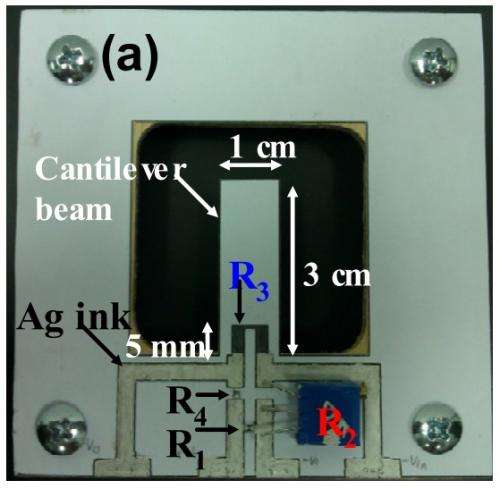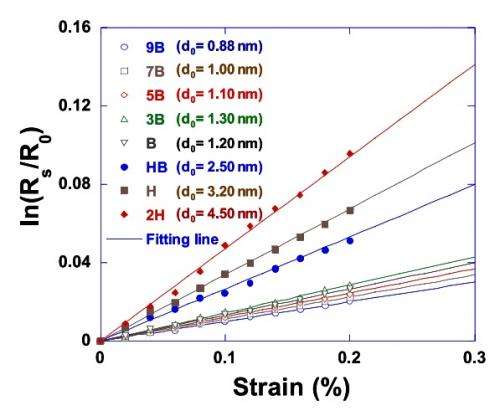February 28, 2014 feature
Pencil drawing of a sensor actually is a sensor

Using graphite pencils to draw on regular paper, researchers can make some very inexpensive piezoresistive (PZR) sensors. Due to the piezoresistive effect, a sensor's resistance changes under an applied strain, allowing it to sense mechanical stress and pressure. The first of these pencil-on-paper PZR sensors was fabricated a few years ago as an alternative to silicon PZR sensors, which are costly and require sophisticated fabrication processes.
"PZR sensors can be drawn by anyone with a graphite pencil and paper," Ting-Kuo Kang, a researcher at Cheng Shiu University in Kaohsiung City, Taiwan, told Phys.org.
Although graphite PZR sensors are much easier to fabricate than silicon ones, they generally are not as sensitive because graphite's electrical properties are not as good as those of silicon. In a new study published in Applied Physics Letters, Kang has further investigated the underlying mechanisms of graphite's PZR properties and improved the sensitivity of graphite-based PZR sensors.
PZR sensitivity is characterized by the gauge factor (GF), which is defined as the ratio of the change in electrical resistance to the applied strain. While silicon PZR sensors have GFs above 100, the GFs of graphite PZR sensors are in the single digits.
In experiments, Kang used 12 different grades of graphite pencils to draw U-shaped PZR sensors on paper. The pencils are graded by their ratio of graphite to clay. Grades ranged from 9B to 2H, where H denotes the hardness caused by the pencil's clay content, and B denotes the blackness due to the graphite content.

The sensors were drawn on paper that was placed on an electric scale in order to measure and maintain a consistent drawing force for each pencil-drawn sensor. The drawings were then glued on printed circuit board (PCB) strips, and a strain gauge mounted on each PCB strip. Then Kang applied cycles of stress to the sensor using a four-point bending technique, and measured the sensor's voltage change under the applied stress through an electric circuit.
He found that different pencil grades produce different GF values, and therefore different PZR sensitivities. Specifically, the higher the ratio of clay to graphite, the greater the change in resistance under the applied stress, and the greater the GF.
Kang explains that these differences can be attributed to variations in the initial tunneling distances between neighboring graphite, with an increase in tunneling distance corresponding to an increase in GF.
"The graphite tunneling effect is from one graphite through the insulator of clay to another graphite," Kang said. "The tunneling structure looks like a metal-insulator-metal."
Currently, PZR sensors made of silicon are used as pressure sensors, accelerometers, and biological sensors, among other applications. As the sensitivity of pencil-drawn graphite PZR sensors continues to improve, they may also be used for these applications. Kang also plans to develop flexible and disposable sensor applications using pencil-on-paper techniques.
More information: Ting-Kuo Kang. "Tunable piezoresistive sensors based on pencil-on-paper." Applied Physics Letters 104, 073117 (2014). DOI: 10.1063/1.4866440
Journal information: Applied Physics Letters
© 2014 Phys.org. All rights reserved.


















